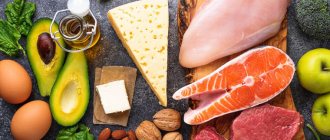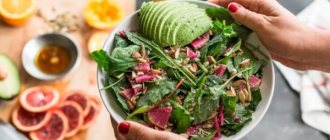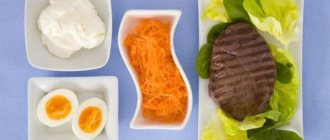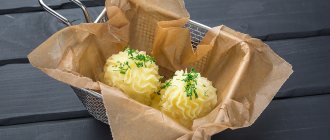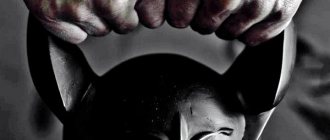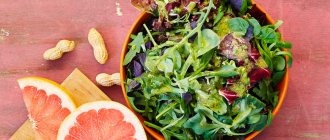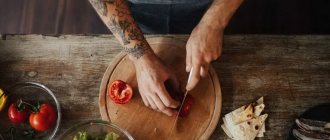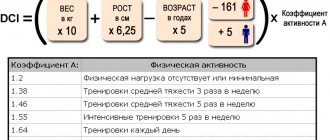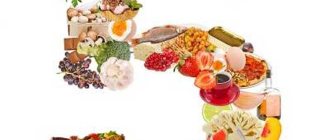Among the huge number of diets today, low-carb ones are gaining popularity, in which certain nutrients in food are limited, but not its volume. Such systems include a high-fat LCHF diet without hunger.
Due to maximum carbohydrate restriction, the body begins to consume energy from alternative sources, namely subcutaneous deposits. This starts metabolic processes that allow you to lose weight, but at the same time eat familiar foods.
General rules
Low-carbohydrate nutrition is represented by a wide range of low-carbohydrate diets, ranging from classic diets with a slight restriction of the carbohydrate component to the Keto diet , in which the traditional biochemical processes of providing the body with energy are excluded and an alternative mechanism for obtaining energy is launched.
One of the varieties of this type of diet is a high-fat, low-carbohydrate diet, the so-called low carb/high fat (LCHF diet), which translates as “low carbohydrates/high fat.” As you know, with normal nutrition, the main source of energy is carbohydrates ( glucose ), which generate energy through the process of metabolism ( glycolysis ). At the same time, nature also provides other metabolic mechanisms for energy production:
- gluconeogenesis - obtaining energy through the utilization of proteins;
- ketogenesis is the production of energy from adipose tissue, which during metabolism breaks down into ketone bodies.
With sufficient consumption of carbohydrates, the process of glycolysis occurs. At the same time, the level of insulin , which triggers the process of glycolysis. The resulting glucose is partially used for:
- energy supply to the body;
- deposited in the liver/muscles in the form of glycogen ;
- turns into fat and is deposited in the body (with excess glucose intake).
insulin is produced , which blocks a metabolic pathway for energy production such as ketogenesis ( lipolysis ). The diet of the vast majority of people in the modern world contains large amounts of starches and sugars. Essentially, the metabolism on this diet functions by producing increased levels of insulin and occurs outside of the process of ketosis , which is regarded as a potentially dangerous condition, accompanied by increased stress on the liver and contributing to the loss of muscle tissue.
However, this is not entirely true; the main danger is the process of “acidification” of the blood, which occurs in a number of diseases/conditions, in particular diabetes , fasting - the formation in large quantities of ketone bodies consisting of acetoacetic / hydroxybutyric acids / acetone , which are transported from the liver to peripheral tissues. But due to their high concentration in the incoming blood, the muscles/organs cannot cope with their oxidation, which leads to the development of ketonemia . Unlike “malignant”, benign dietary ketosis occurs against the background of normal insulin levels without symptoms of intoxication of the body.
Thus, the main goal of a high-fat diet is to achieve a state of dietary ketosis/lipolysis, in which the body begins to use its own stored fats to meet energy needs. In fact, the phenomenon of ketosis should be considered as a tool for transferring the body to the process of burning fats, which first break down into glycerol and free fatty acids, which continue, accordingly, to break down into so-called “ketone bodies” with the formation of a new fatty acid, which is used as fuel. Ketones are excreted from the body through the respiratory tract and urine.
The downside of a low-carb diet is the potentially high risk of muscle loss due to protein breakdown and cortisol- . This process is prevented by growth hormone, which counteracts cortisol, activating the process of penetration of amino acids into the muscles. You can also paralyze the effects of cortisol by eating more protein. In this case, the protein supplied with food will be used to obtain energy, and muscle protein will not be involved in the process.
According to scientific research, for this you need to get 2.5-3.0 protein/1 kg of body weight. But a more correct approach to the amount of protein consumed is the level of physical activity. That is, if you need to speed up fat burning and at the same time increase muscle mass, the protein content in the diet should be on average 3 g/kg of weight, and if there is no goal to build muscle, with standard physical activity, the protein component in the diet should be within the physiological range norms.
Thus, the diet should be high in fat, physiologically sufficient in protein and very low in carbohydrates (20-50 g/day). It is also important to constantly monitor the total carbohydrate content, especially the so-called “hidden” carbohydrates, and maintain a high level of fat in the diet so as not to leave the ketosis process. To do this, the level of carbohydrate content should not exceed an average of 50 g/day. Many people do not understand the difference between ketogenic diets and a standard low-carbohydrate diet with carbohydrate restriction in the diet at the level of 150-200 g/day, in which the process of ketosis does not start.
That is, the compositions of the main dietary macronutrients in traditional low-carbohydrate diets do not meet the requirements of ketogenic diets. Ideally, when trying to lose weight, it is advisable not to leave ketogenesis before reaching the target level, since this state is quite comfortable for losing weight and, moreover, there is no need to re-activate this mechanism. It should be remembered that stopping ketogenesis is quite simple, even without knowing it. Therefore, remember that even a small intake of an unexpected additional amount of carbohydrates (a bun, a bagel) will take your body out of ketosis and the process will have to be restarted. Signs of the body’s transition to ketogenesis are:
- decreased appetite;
- the appearance of ketones in the urine (test with special strips);
- the appearance of the smell of acetone from the mouth, sweat, urine;
- improved mood, increased energy, increased strength/vigor.
Classic low-carbohydrate diets (low-fat/low-calorie), unlike keto diets, are accompanied throughout their entire duration by lethargy, weakness, a feeling of constant hunger, and decreased performance. At the same time, average fat burning, low insulin , and loss of muscle mass are observed.
Many may wonder if there are differences between the keto diet and the LCHF diet, and if so, what are they? There is no fundamental difference. Each of them is based on the process of ketosis, but the LCHF diet is a milder nutritional option. Now let's look at the LCHF diet in more detail.
The approximate standard for the content of basic food nutrients in the diet is 20% proteins, 70-75% fats and 5-10% carbohydrates. With a strict version of the LCHF diet, carbohydrate intake is limited to 10-20 g/day, with a more liberal version - 50 g. At the same time, the ratio of proteins and fats in the first days of the diet should be 1:1, and only after the body passes through the “metabolic threshold” the level of fat in the diet increases to 70-75%.
The question of the total calorie content of the daily diet is also of some interest, since most people assume that if there are no strict restrictions on protein and fatty foods, then they can be consumed in any quantity. This is not entirely correct, since the overall energy value of the diet is of primary importance, but it all depends on the task at hand.
If your goal is simply to lose weight, then it is recommended to reduce the caloric content of your daily diet by 500-600 kcal from the norm. If your goal is to gain muscle mass while burning fat, then the calorie content of your diet increases by 500-600 Kcal. These indicators can vary significantly depending on the level of metabolism/energy consumption of the body.
The positive aspects of the LCHF diet when trying to lose weight are:
- Body weight is lost due to adipose tissue.
- Weight loss is accompanied by a general improvement of the body, due to the stimulation of CMA autophagy - a cellular process of removing organelles, proteins and foreign bodies from the aqueous component of the cell ( cytosol ) and transporting them to lysosomes for disposal. In addition, against the background of low-carbohydrate ketogenic diets, metabolic effects such as a decrease in blood glucose levels, excretion of ketone bodies in the urine, normalization of insulin levels/lipid profile, and normalization of blood pressure .
- Weight loss occurs without the feeling of hunger and in a state of psychological comfort.
When building an LCHF diet, carbohydrates are primarily limited. Sugars and their artificial substitutes, sweets, sweet juices, cakes, chocolate, buns, cakes, pastries, honey, jam, ice cream, jam, honey, sauces with added sugar, sweet juices, curds, jelly/compotes, sweet yoghurts are excluded.
The list of prohibited products includes products containing starch (pasta, bread - black/white, cereals, chips, rice, muesli and all whole grain products - bread, sunflower seeds), legumes.
Sweet fruits, dried fruits and all root vegetables (beets, carrots, celery root, potatoes) containing a lot of starch and sugars, alcoholic beverages, especially beer, kvass, sweet/semi-sweet wines are excluded.
Above-ground vegetables (eggplant, cucumbers, tomatoes, onions, all types of cabbage, zucchini/zucchini, leafy greens) may be present in the diet as a carbohydrate component. Unsweetened fruits/berries and nuts (cashews, walnuts, flaxseed, sesame) are allowed in minimal quantities.
It is recommended to exclude trans fats from the fat part of the diet (spreads with trans fats, margarine); if lactose is intolerant, use whole/skimmed milk. Protein products and fatty foods are allowed - concentrated fatty broths, fatty meats/sea and river fish (cod, salmon, salmon, herring), meat products (bacon, boiled pork, balyk, sausages), fatty poultry meat (goose, duck), butter/vegetable oil, high-fat dairy/fermented milk products, sauces/homemade mayonnaise, fatty hard/soft cheeses, eggs, mushrooms, seafood (shrimp, squid), bran.
It is recommended to use animal proteins as the protein component. It is extremely important to control the amount of free fluid consumed, the volume of which should be at least 3.0 l/day at the rate of 40 ml/1 kg of weight. The salt content and the limitation of various types of pickles are also slightly limited. Diet: at least 5 times a day with an interval between meals of no more than 3-4 hours. The last meal is 3-3.5 hours before bedtime.
How many times a day do you eat on LCHF and how to have breakfast
In most diets, breakfast is the most important and obligatory part of the regime. Low-carbohydrate diet does not imply clear requirements for the period and number of meals.
The authors of the LCHF system claim that not eating in the morning does not lead to overeating during the day. Scientists advise building your nutrition schedule in accordance with the needs of the body.
Recommendations for diet consist of only three points:
- eat any time you are hungry;
- do not overeat;
- It is advisable to eat 3-4 times a day.
It is important not to start eating food without feeling hungry and not to overuse portion sizes.
Authorized Products
The diet of the LCHF diet is formed mainly due to:
- fatty meat/fish broths and first courses based on them (solyanka, borscht);
- red meat of fatty varieties in any culinary processing, meat products (ham, bacon, sausages, smoked meats), poultry meat (chicken, duck, goose);
- fatty varieties of river/sea fish (salmon, tuna, herring), seafood;
- chicken eggs, fatty sauces;
- high-fat dairy products (butter, cream, sour cream, cottage cheese, hard cheese);
- vegetable oils (olive, corn, sunflower, flaxseed);
- above-ground vegetables (celery stalks, eggplants, cucumbers, tomatoes, onions, all types of cabbage, zucchini/zucchini, green beans, leafy greens).
- nuts/seeds (walnuts, cashews, peanuts, flax seeds, olives, sesame).
Table of permitted products
| Proteins, g | Fats, g | Carbohydrates, g | Calories, kcal | |
Vegetables and greens | ||||
| green peas | 5,0 | 0,2 | 13,8 | 73 |
| zucchini | 0,6 | 0,3 | 4,6 | 24 |
| Brussels sprouts | 4,8 | 0,0 | 8,0 | 43 |
| cabbage | 1,2 | 0,2 | 2,0 | 16 |
| cauliflower | 2,5 | 0,3 | 5,4 | 30 |
| cucumbers | 0,8 | 0,1 | 2,8 | 15 |
| olives | 0,8 | 10,7 | 6,3 | 115 |
| iceberg lettuce | 0,9 | 0,1 | 1,8 | 14 |
| celery | 0,9 | 0,1 | 2,1 | 12 |
| green beans | 2,8 | 0,4 | 8,4 | 47 |
Mushrooms | ||||
| mushrooms | 3,5 | 2,0 | 2,5 | 30 |
Nuts and dried fruits | ||||
| nuts | 15,0 | 40,0 | 20,0 | 500 |
| peanut | 26,3 | 45,2 | 9,9 | 551 |
| flax seeds | 18,3 | 42,2 | 28,9 | 534 |
Cereals and porridges | ||||
| white rice | 6,7 | 0,7 | 78,9 | 344 |
Raw materials and seasonings | ||||
| mayonnaise | 2,4 | 67,0 | 3,9 | 627 |
Dairy | ||||
| milk 3.2% | 2,9 | 3,2 | 4,7 | 59 |
| condensed milk | 7,2 | 8,5 | 56,0 | 320 |
| kefir 3.2% | 2,8 | 3,2 | 4,1 | 56 |
| cream 20% (medium fat content) | 2,8 | 20,0 | 3,7 | 205 |
| sour cream 25% (classic) | 2,6 | 25,0 | 2,5 | 248 |
| Ryazhenka 6% | 5,0 | 6,0 | 4,1 | 84 |
Cheeses and cottage cheese | ||||
| cheese | 24,1 | 29,5 | 0,3 | 363 |
Meat products | ||||
| pork | 16,0 | 21,6 | 0,0 | 259 |
| salo | 2,4 | 89,0 | 0,0 | 797 |
| boiled beef | 25,8 | 16,8 | 0,0 | 254 |
| boiled veal | 30,7 | 0,9 | 0,0 | 131 |
| rabbit | 21,0 | 8,0 | 0,0 | 156 |
| bacon | 23,0 | 45,0 | 0,0 | 500 |
| ham | 22,6 | 20,9 | 0,0 | 279 |
| raw smoked pork loin | 10,5 | 47,2 | — | 467 |
| meat pate | 16,4 | 23,3 | 0,4 | 277 |
| pork cutlets | 13,6 | 45,7 | 8,8 | 466 |
Sausages | ||||
| smoked sausage | 28,2 | 27,5 | 0,0 | 360 |
| dry-cured sausage | 24,1 | 38,3 | 1,0 | 455 |
| smoked sausage | 9,9 | 63,2 | 0,3 | 608 |
| sausages | 10,1 | 31,6 | 1,9 | 332 |
| sausages | 12,3 | 25,3 | 0,0 | 277 |
Bird | ||||
| boiled chicken | 25,2 | 7,4 | 0,0 | 170 |
| turkey | 19,2 | 0,7 | 0,0 | 84 |
| duck | 16,5 | 61,2 | 0,0 | 346 |
| goose | 16,1 | 33,3 | 0,0 | 364 |
Eggs | ||||
| soft-boiled chicken eggs | 12,8 | 11,6 | 0,8 | 159 |
Fish and seafood | ||||
| pink salmon | 20,5 | 6,5 | 0,0 | 142 |
| Red caviar | 32,0 | 15,0 | 0,0 | 263 |
| cod roe | 24,0 | 0,2 | 0,0 | 115 |
| salmon | 19,8 | 6,3 | 0,0 | 142 |
| seafood | 15,5 | 1,0 | 0,1 | 85 |
| sturgeon | 16,4 | 10,9 | 0,0 | 163 |
| canned fish | 17,5 | 2,0 | 0,0 | 88 |
| herring | 16,3 | 10,7 | — | 161 |
| cod (liver in oil) | 4,2 | 65,7 | 1,2 | 613 |
| tuna | 23,0 | 1,0 | — | 101 |
| acne | 14,5 | 30,5 | — | 332 |
| sprats | 17,4 | 32,4 | 0,4 | 363 |
Oils and fats | ||||
| vegetable oil | 0,0 | 99,0 | 0,0 | 899 |
| butter | 0,5 | 82,5 | 0,8 | 748 |
| linseed oil | 0,0 | 99,8 | 0,0 | 898 |
| animal fat | 0,0 | 99,7 | 0,0 | 897 |
| cooking fat | 0,0 | 99,7 | 0,0 | 897 |
Non-alcoholic drinks | ||||
| mineral water | 0,0 | 0,0 | 0,0 | — |
| green tea | 0,0 | 0,0 | 0,0 | — |
| black tea | 20,0 | 5,1 | 6,9 | 152 |
| * data is per 100 g of product | ||||
Diet recipes
The exclusion of plant and animal fats from the diet is the basis of most popular diets. Many women struggling with extra pounds are wondering: is it possible to lose weight using any other method?
The answer is definitely positive. Many women have experienced all the benefits of the new, revolutionary diet, which is commonly called LCHF.
Its main principle is an almost complete rejection of carbohydrates, while fats are consumed in unlimited quantities.
You will no longer have to suffer from bouts of hunger, carefully count the calorie content of the foods you eat, or try to keep portions to a minimum.
All you have to do is stop eating sugar and starch. Giving up these products is not as difficult as it might seem at first glance.
If you manage to do this, the reward will not be long in coming. The hated kilograms will begin to melt literally before our eyes. This is precisely the opinion of those losing weight who have chosen this innovative low-carbohydrate diet.
You should not think that the diet consists of monotonous, unappetizing and bland dishes. At least this definitely does not apply to LCHF. There are many options for delicious dishes that anyone can prepare for themselves without any problems.
Here are just a few recipes that will help you understand how tasty and enjoyable the process of losing weight can be.
Source: stroini-e.ru
Chicken soup with mushrooms and bacon
Ingredients for making soup for 3-4 servings:
- one large or medium-sized leg;
- 100 g bacon;
- 150 g mushrooms;
- bulb;
- 3 tablespoons oil (for frying);
- sesame or almond flour 2-5 tablespoons;
- seasonings to taste.
The meat is filled with water and boiled for an hour. The foam that forms on the surface of the water must be removed. The finished broth should be strained.
Allow the ham to cool and separate the meat from the bone, disassembling it into fibers. The chopped meat is sent back to the broth.
Finely chop the bacon, onion and mushrooms. Next, these ingredients are mixed and sent to a well-heated frying pan. If necessary, add spices to the frying and carefully place in the broth.
The flour is sent there and brought to a boil again. Flour will give the soup a creamy consistency. The degree of thickness can be adjusted at your discretion. You can add raw yolks to the soup. It is recommended to serve the finished dish with sour cream or butter.
Source: stroini-e.ru
Beefsteak Tartar
For 3-4 servings you will need:
- beef tenderloin – 250 g;
- 1 onion;
- Greenery;
- 5 tablespoons of soy sauce;
- 3 teaspoons lemon juice;
- 3 teaspoons mustard;
- 1 teaspoon freshly ground black pepper;
- 1 teaspoon Tabasco sauce;
- a few tablespoons of olive oil.
Finely chop the meat, herbs and onions. Next, these ingredients are mixed and placed in the refrigerator for thirty minutes. When the minced meat has cooled sufficiently, you need to make neat balls out of it using a culinary ring.
The finished dish is served with toast and greens. As a side dish you can serve baked or fried vegetables (peppers, eggplants), pickled cucumbers, anchovies.
Source: stroini-e.ru
Avocado and zucchini soup
Products:
- zucchini - 2 pcs.,
- avocado - 1 pc.,
- processed cheese - 1-2 pcs.,
- garlic - to taste,
- pine nuts - to taste.
How to cook: Fry the garlic in vegetable oil. Finely chop the zucchini and add to the garlic. Simmer covered over low heat until done.
Grate the processed cheese. Place all ingredients in a saucepan and fill with hot water. Bring to a boil and turn off the heat. Slice the avocado and add to the pan. Beat everything with a blender and add nuts.
Source: tvoy-ves.ru
Beefsteak “Spicy Beef”
Products:
- Beef tenderloin - 500 gr.,
- onion - 1 pc.,
- soy sauce - 5 tbsp. spoons,
- hot sauce “Tabasco” - 2 teaspoons,
- lemon juice - 2 tbsp. spoons,
- mustard - 3 tbsp. spoons,
- pepper - to taste,
- dill - to taste.
How to cook: Finely chop the beef, onion and herbs. Mix all ingredients and refrigerate for 30 minutes. Then take it out, form the steaks and fry with olive oil.
Source: tvoy-ves.ru
Fully or partially limited products
The LCHF diet includes dietary restrictions:
- sugar, jam, jams, honey, sweets, chocolate, ice cream, sorbitol/fructose products;
- white bread, cereals, pasta, crackers, pastries, cookies, cakes, waffles;
- starchy vegetables (potatoes, beets, carrots, eggplants, celery root);
- sweet fermented milk products, various dried fruits, sweet carbonated drinks, milk, powdered drinks, bran;
- sweet fruits and juices from them (grapes, banana, melon, watermelon), beer, kvass, sweet/semi-sweet/fortified wines, caffeine-containing drinks (cola, Pepsi), jelly, compotes.
Table of prohibited products
| Proteins, g | Fats, g | Carbohydrates, g | Calories, kcal | |
Vegetables and greens | ||||
| potato | 2,0 | 0,4 | 18,1 | 80 |
| carrot | 1,3 | 0,1 | 6,9 | 32 |
| radish | 1,2 | 0,1 | 3,4 | 19 |
| turnip | 1,5 | 0,1 | 6,2 | 30 |
| beet | 1,5 | 0,1 | 8,8 | 40 |
Berries | ||||
| grape | 0,6 | 0,2 | 16,8 | 65 |
Snacks | ||||
| potato chips | 5,5 | 30,0 | 53,0 | 520 |
Cereals and porridges | ||||
| buckwheat porridge with milk | 4,2 | 2,3 | 21,6 | 118 |
| semolina | 10,3 | 1,0 | 73,3 | 328 |
| pearl barley | 9,3 | 1,1 | 73,7 | 320 |
| Wheat groats | 11,5 | 1,3 | 62,0 | 316 |
| millet cereal | 11,5 | 3,3 | 69,3 | 348 |
| white rice | 6,7 | 0,7 | 78,9 | 344 |
Flour and pasta | ||||
| pasta | 10,4 | 1,1 | 69,7 | 337 |
| spaghetti | 10,4 | 1,1 | 71,5 | 344 |
| pancakes | 6,1 | 12,3 | 26,0 | 233 |
| vareniki | 7,6 | 2,3 | 18,7 | 155 |
| dumplings | 11,9 | 12,4 | 29,0 | 275 |
Bakery products | ||||
| vysivkovy bread | 9,0 | 2,2 | 36,0 | 217 |
| Rye bread | 6,6 | 1,2 | 34,2 | 165 |
Confectionery | ||||
| jam | 0,3 | 0,2 | 63,0 | 263 |
| jam | 0,3 | 0,1 | 56,0 | 238 |
| candies | 4,3 | 19,8 | 67,5 | 453 |
| cookie | 7,5 | 11,8 | 74,9 | 417 |
| crackers with raisins | 8,4 | 4,9 | 78,5 | 395 |
| dough | 7,9 | 1,4 | 50,6 | 234 |
Ice cream | ||||
| ice cream | 3,7 | 6,9 | 22,1 | 189 |
Cakes | ||||
| cake | 4,4 | 23,4 | 45,2 | 407 |
Chocolate | ||||
| chocolate | 5,4 | 35,3 | 56,5 | 544 |
Raw materials and seasonings | ||||
| honey | 0,8 | 0,0 | 81,5 | 329 |
Dairy | ||||
| fruit yogurt 3.2% | 5,0 | 3,2 | 8,5 | 85 |
Alcoholic drinks | ||||
| liquor | 0,3 | 1,1 | 17,2 | 242 |
| beer | 0,3 | 0,0 | 4,6 | 42 |
| cider | 0,2 | 0,3 | 28,9 | 117 |
Non-alcoholic drinks | ||||
| cola | 0,0 | 0,0 | 10,4 | 42 |
| coffee with milk and sugar | 0,7 | 1,0 | 11,2 | 58 |
| Pepsi | 0,0 | 0,0 | 8,7 | 38 |
| energy drink | 0,0 | 0,0 | 11,3 | 45 |
Juices and compotes | ||||
| compote | 0,5 | 0,0 | 19,5 | 81 |
| grape juice | 0,3 | 0,0 | 14,0 | 54 |
| pear juice | 0,4 | 0,3 | 11,0 | 46 |
| jelly | 0,2 | 0,0 | 16,7 | 68 |
| raspberry juice | 0,8 | 0,0 | 24,7 | 100 |
| * data is per 100 g of product | ||||
Menu (Power Mode)
The menu for a week of the LCHF diet is based on a list of allowed/prohibited foods. The main task when creating a menu is to control the total content of the carbohydrate component in the diet and maintain a high level of fat in the diet so as not to interrupt the ketogenesis process.
Therefore, when drawing up a menu for the day/week, it is necessary to carefully examine the composition of products for “hidden” carbohydrates. The rate of protein consumption and the total calorie content of the diet depends on the goal - losing weight, burning fat while maintaining weight, gaining muscle mass.
Basic Rules
The LCHF diet, depending on the daily amount of carbohydrates, has three main options: strict (20–25 g), moderate (25–50 g), liberal (50–100 g). The latter is suitable for those who exercise several hours a week, are not overweight, do not get tired at work and do not experience painful pangs of hunger. The high-fat, low-carb LCHF diet has a few more rules:
- Create a menu taking into account the following proportions: fats – 70%, proteins – 20%, carbohydrates – 10%.
- Cook foods using minimal heat treatment. Boiled, baked or steamed dishes are healthier than fried ones.
- Drink a glass of water half an hour before meals.
Advantages and disadvantages
| pros | Minuses |
|
|
Comments from nutritionists
Against the background of the LCHF diet, functional disorders of the gastrointestinal tract (bloating and heaviness in the stomach, constipation / diarrhea ), general weakness, fatigue, nausea, insomnia , headache , dizziness , thirst are possible. Such phenomena most often occur during the transition of the body from glycolysis to ketogenesis , so it is recommended to reduce this period if possible by increasing physical activity and minimally including a carbohydrate component in the diet to 6-10 g/day and a gradual increase to 30-40 g/day day. At this time, it is important to activate the kidneys and ensure rapid evacuation of intestinal contents.
Limiting carbohydrates and, accordingly, fiber contributes to the development/colonization of the intestines by pathogenic microflora with a high risk of developing dysbiosis /decreased immunity . It is recommended to periodically include some vegetables/fruits (cabbage, sour apples) in the diet in minimal quantities.
For those on a diet with minimal carbohydrates, it is recommended to take fiber supplements containing both soluble and insoluble fiber. These drugs do not contain carbohydrates. However, it should be remembered that it is better to use fiber in powder form, dissolving in water. When consumed in dry form, additional intake of large amounts of water is necessary.
Since the LCHF diet does not provide the body with all the necessary micronutrients, it is recommended to take supplements containing a full spectrum of water/fat-soluble vitamins and minerals.
A little about keto diets
The pioneer of the fat diet can be called William Banting, who not only lost weight using his own method, but also told the whole world about it in 1863.
This was a real revolution in weight loss, this method is sometimes called the “Banting diet”. Meanwhile, the founder of the LCHF diet is considered to be William Ebstein, a German doctor of the 19th century.
The trend of using a high-fat diet came to us from Sweden, where 25% of the population follows the corresponding menu, and the food intake system itself is supported by the state.
Initially, the principle of a high-fat, low-carbohydrate diet was not intended for those who wanted to lose weight. As a result of experimental studies in the 20th century, it was proven that the diet has a striking effect in the treatment of children with epilepsy.
Yes Yes exactly! A large amount of fat promotes the regeneration of brain cells and restoration of the body, while carbohydrates provide a lot of glucose, which provokes attacks.
Today, a similar dietary restriction, containing the principles of the keto diet, is also prescribed for the treatment of epileptic patients. But in the modern interpretation, there are nutrition systems of Atkins and Alexey Kovalkov.
They are used for active weight loss, at the same time they have proven effective in the fight against epilepsy in the adult population: ketone bodies, the number of which increases during ketosis, reduce the frequency of attacks.
Source: aveslim.ru
Reviews and results
Reviews of the LCHF diet among its practitioners vary significantly from enthusiastic to complete denial.
- “... In my many attempts to lose my extra 15 kg of weight, I found the LCHF diet, which I decided to practice. Despite the clear logic of all the processes on this diet, I was still afraid of it, but decided to stay on it for only 2 weeks. Strictly controlled carbohydrates. For the first 4 days I felt terrible (weakness, irritability). But from day 5 the condition improved noticeably. There was a smell of acetone when exhaling, I drank a lot of liquid. Lost 6.5 kg in 2 weeks”;
- “... I found a description of this diet in the literature and wanted to practice it, but did not dare, because on the Internet there were numerous negative reviews about the LCHF diet, and not just from people practicing it, but from doctors, according to whom, to go on any ketone diet without There are no specific medical indications, since a pronounced imbalance of fats/proteins/carbohydrates slows down metabolic processes and subsequently provokes weight gain, in even greater quantities. In addition, a diet based on fat and protein often provokes salt deposition and gout, increased cholesterol levels, which increases the risk of developing cardiovascular diseases, and decreased testosterone levels.”
Menu for three weeks according to the Low Carb High Fat protocol
The LCHF diet does not have a strict eating schedule. According to reviews from those losing weight, using this system it is enough to eat 2 to 3 times a day, since fatty foods fill you up for a long time, and the absence of fast sugars in the menu prevents permanent raids on the refrigerator. With this nutritional algorithm, a person gets rid of food addiction and effectively loses weight. LCHF adherents usually have breakfast with a cup of coffee with added cream or coconut oil, egg dishes, and full-fat cottage cheese with sour cream. After such a start to the day, you don’t feel like eating until lunch, and sometimes even dinner. For lunch, a generous portion of fish or meat with stewed or fresh vegetables is suitable. Dinner time is not limited by time frame. The evening meal can duplicate the composition of lunch.
First week
| Breakfast | Dinner | Dinner | |
| Monday | Egg roll with Dutch cheese and mayonnaise | Beef steak, cucumber, tomato and olive salad | “Sandwiches” of fried zucchini and homemade sausage |
| Tuesday | Bulletproof coffee | Pork stewed with zucchini | Fresh vegetable salad, a few slices of boiled pork |
| Wednesday | Egg and Bacon Muffins | Homemade sausage, fresh cucumber | Fat cottage cheese with herbs and salt |
| Thursday | Scrambled eggs with butter | Chicken chops, steamed cauliflower, drizzled with melted butter | Salad of cucumbers, tomatoes, olives and feta with extra virgin olive oil |
| Friday | Cheese and vegetable slices, omelette with cream | Beef goulash (without flour dressing) with boiled broccoli | Salad of green onions, eggs, radishes, parsley, fresh cucumbers with sour cream |
| Saturday | Boiled eggs with butter or homemade mayonnaise | Mackerel baked with herbs and lemon, fresh vegetable salad | Homemade sausages, sauerkraut with cranberries and vegetable oil |
| Sunday | Chicken roll in nut breading, lettuce | Pork skewers, grilled bell peppers | Mushrooms stewed in rich sour cream |
Second week
| Breakfast | Dinner | Dinner | |
| Monday | Scrambled eggs with brisket, a couple of chocolate slices with stevia, a cup of coffee | LCHF-okroshka with mineral water | Cheese chips with avocado sauce |
| Tuesday | Cheesecakes with sour cream | Chicken gizzards stewed with vegetables | Beef sausage, tomato and cucumber salad with extra virgin olive oil dressing |
| Wednesday | Omelet with herbs, cucumber | Roast pork, fresh cabbage salad with olive oil | Eggplant rolls stuffed with cottage cheese |
| Thursday | LCHF pancakes with curd cheese and berries | Kiev cutlet in nut breading, fresh vegetables | Greek salad |
| Friday | Sandwich made from LCHF bread, butter with herbs and lightly salted salmon | Cod cooked with cheese and cream | Cup of black tea with cream |
| Saturday | A few slices of brisket and cheese, scrambled eggs with tomatoes, fresh herbs | Chicken wings baked in the oven, vegetable stew | Shirataki noodles with bacon and cream |
| Sunday | Coconut cookies, coffee with cream | Chicken liver stewed in cream. Zucchini and tomato stew | LCHF zucchini pancakes with sour cream and garlic sauce |
Third week
| Breakfast | Dinner | Dinner | |
| Monday | Avocado, handful of walnuts | Cauliflower and chicken breast fried in butter, lettuce | Fried bacon, cauliflower puree |
| Tuesday | Curd pancakes with sour cream | Steak, pumpkin puree | Rolls of cucumbers, red fish and curd cheese |
| Wednesday | Cream dessert of mascarpone and fresh berries | Mushroom cream soup | Fried suluguni with chopped fresh vegetables |
| Thursday | Handful of almonds, cup of fresh or thawed berries | Chicken curry | Champignons baked with minced beef and cheese |
| Friday | Nut cookies, cup of coffee | Trout and vegetables baked in coconut oil | Avocado with lemon juice |
| Saturday | LCHF pancakes with ham and soft cheese | Eggplant caviar, salmon shish kebab | Salad of shrimp, eggs, arugula, dressed with mayonnaise |
| Sunday | Thin omelette stuffed with arugula, tomatoes and chicken breast | Zucchini boats with minced pork and cheese | Salmon muffins |
A high-fat diet is very filling, and there is little need for snacking. But if you are still hungry and you can’t have a full lunch or dinner, you can snack on sliced cheese, a few nuts, a couple of olives, a cup of fresh berries, a glass of full-fat kefir or fermented baked milk.
